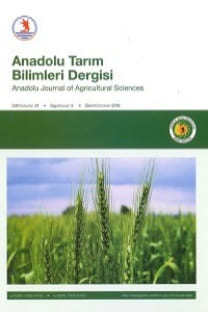Direct Black 22 azo boyasının Pleurotus Ostreatus ile Biyogiderimi ve Optimizasyonu
Biological Treatment and Optimization of Direct Black 22 Azo Dyes with Pleurotus Ostreatus
Pleurotus ostreatus Azo dyes, Biosorption, Biodegradation,
___
- An, H., Qian, Y., Gu, X., Tang, W. Z., 1996. “Biological Treatment of Dye Waste water using Anaerobic-Oxic System”, Chemosphere, 33(12): 2533-2452.
- Ardon, O., Kerem, Z., Hadar, Y., 1998. “Enhancment of Lignin Degradation and Laccase Activity in Pleurotus ostreatus by Cotton Stalk Extract”, Canadian Journal of Microbiology, 44: 676-680.
- Başer, İ., İnanıcı, Y., 1990. “Boyar Madde Kimyası”, Marmara Üniversitesi Teknik Eğitim Fakültesi Yayınları, İstanbul, 47-52, 35-37, 90-187.
- Cripss, C., Bumpus, J.A., Aust, S.D., 1990. “Biodegradation of azo and hetero- cyclic dyes by Phanerochaete chrysosporium”, Appl.Environ. Microbiol. (56): 1114- 1118.
- Fu, Y., Vıraraghavan, T., 2002. “Removal of Congo Red From an Aqueous Solution by Fungus Aspergillus niger”, Advances in Environmental Research, 7: 239-247.
- Kapdan, K.I., Kargi, F., 2001. “Biological Decolorization of Textile Dyestuff Containing Wastewater by Coriolus versicolor in Rotating Biological Contactor”, Enzyme and Microbial Technoloy, 30: 195-199.
- Kuai, L., De Vreese, I., Vandevivere, P., 1998. “GACAmended UASB Reactor for The Stable Treatment of Toxic Textile Wastewater”, Environmental Technology, 19: 1111-17.
- Murray, P.R. 1990. “Medical Microbiology”, St. Louis: Mosbay, 616.
- Pagga, U., Brown, D., 1986. “The Degradation of Dyestuffs: Part II Behaviour of Dyestuffs in Anaerobic Biodegradation Tests”, Chemosphere, 15(4): 479-491.
- Platt, M.K., Hadar, Y., Chet, I., 1984. “Fungal Activities Involve in Lignocellulose Degradation by Pleurotus”, Applied Microbiology and Biotechnology, 20: 150-154.
- Seesuriyachana, P., Takenakab, S., Kuntiyaa, A., Klayraungc, S., Murakamib, S., Aokib, K., 2007. “Metabolism of azo dyes by Lactobacillus casei TISTR 1500 and effects of various factors on decolorization”, Water Research. 41: 985 – 992.
- Stolz A., 2001. “Basic and Applied Aspects in the Microbial Degradation of Azo Dyes, App.”, Microbiol Biotechnol. 56: 69-80.
- Şişli, N., 1996. “Çevre Bilim Ekoloji” H.Ü. Fen Fakültesi. Ankara.
- Taner, T., 2006. “Katyonik Alkiltrimetilamonyum Bromür Surfaktantlar İle C.I. Reactive Orange 16 Etkileşimi”, Yüksek Lisans Tezi, T.Ü Fen Bil. Enst., Edirne. Wesenberg, D., Buchon, F., Agathos, S.N., 2002.
- “Degradation of Dye Containing Textile Effluent by Agaric White - Rot Fungus Clitocybula dusenii”, Biotechnology Letters, 24: 989-993.
- Zadrazıl, F., Brunnert, F., 1981. “Investigation of Physical Parameters Important for Solid State Fermentation of Straw by White Rot Fungi, Eur. J. Appl.”, Microbiol Biotechnol, 11, 183-188.
- Zaoyan, Y., Ke, S., Guanglıng, S., Fan, Y., Jınshan, D., Huanıan, M., 1992. “Anaerobic – Aerobic Treatment of a Dye Wastewater by Combination of RBC With Activated Sludge”, Water Sci. Technol., 26(9-11): 2093- 96
- Zhang, F., Knapp, J.S., Tapley, K.N., 1999. “Decolourisation of Cotton Bleaching Effluent with Wood Rotting Fungus”, Water Resources, 33: 919-928.
- ISSN: 1308-8750
- Yayın Aralığı: 3
- Başlangıç: 1986
- Yayıncı: Ondokuz Mayıs Üniv. Ziraat Fak.
Mehmet Ali Sarıdaş, Sevgi Paydaş Kargı, Şenay Karabıyık, Hayriye Yıldız Daşgan
Doğan IŞIK, Emine KAYA ALTOP, Hüsrev MENNANA
Ayhan HORUZ, İmanverdi EKBERLİ, Ahmet KORKMAZ, Güney Akınoğlu, Nutullah Özdemir
Burhan DURGUN, Veli UYGUR, Burak DURGUN, Enise SUKUŞU
Samsun ili ıspanak üretim alanlarında enfeksiyon oluşturan virüslerin belirlenmesi
Murat GÜNGÖR, Hüseyin UZUNBACAK, Nazlı Dide Kutluk YILMAZ, Mehmet Ali ŞEVİK
Bingöl İl merkezinde yaşayan hanehalklarının kırmızı et talebini etkileyen faktörlerin analizi
Ersin KARAKAYA, Semiha KIZILOĞLU
Aydın ili Söke ilçesinde pamuk üreticilerinin tohum tercihlerini etkileyen faktörler
H. Asım Adalıoğlu, İ.Caner Akkuş, Canan Abay, M.Çağla Örmeci Kart
Süleyman ÇALIŞLAR, Hüseyin KUŞTİMUR
Nutullah ÖZDEMİR, Ayhan HORUZ, İmanverdi EKBERLİ, Güney AKINOĞLU, Ahmet KORKMAZ
Aspir (Carthamus tinctorius L.)’de yaprak dikenliliği ve çiçek renginin genetiği
